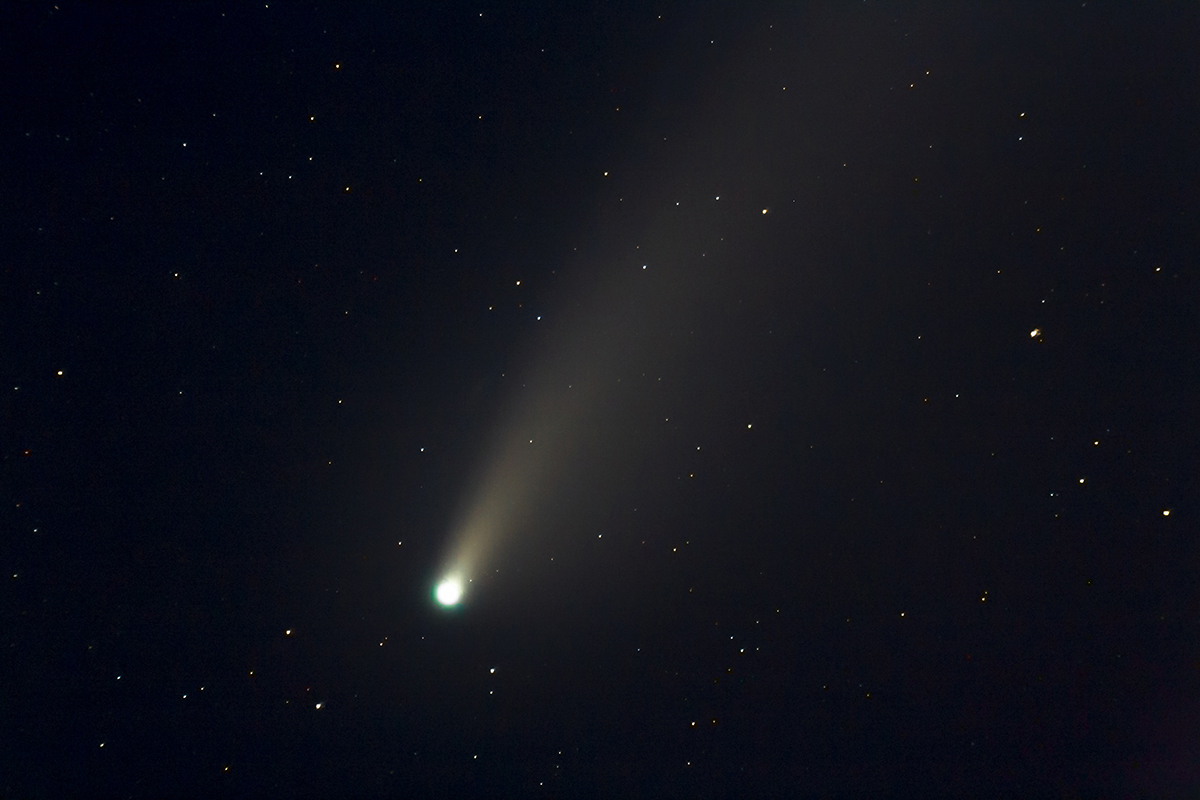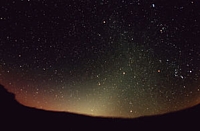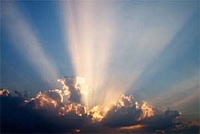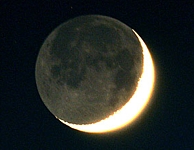
The phenomena that we see in the sky have always caused admiration and curiosity. Many gave way to astronomical calculations of ancient civilizations, as well as interpreting them in a religious/spiritual framework, where certain events represented an omen or were associated with divine intervention. But given that today these phenomena have a clear scientific explanation, it is important for the amateur astronomer to have knowledge of the phenomena visible in the sky.
There are different types of celestial phenomena. Some are sporadic events of an astronomical nature (e.g. a comet visible in the sky), are associated with refraction dynamics in the atmosphere, meteorological causes, human-made objects or are positional phenomena, and can be predicted without major difficulty. Below is a list:
Phenomena of atmospheric/meteorological nature
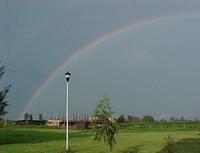
It is one of the most well-known and beautiful phenomena that occur in the sky. They occur when, during a rainy day, raindrops act as mirrors that disperse light in all directions, breaking it down and forming the rainbow. This is formed with the Sun's rays that impact the drops and are dispersed at an angle of ~138º, forming the arc; The ray of light enters the drop, refracting, then moving towards its opposite end and reflecting on its internal face, to finally refract when leaving the drop as decomposed light; Rainbows usually last up to 3 hours, and are always seen in the opposite direction from the Sun.
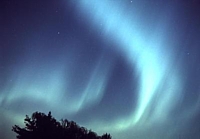
They are phenomena produced at latitudes close to the Earth's magnetic poles, as they are produced through the interaction of the latter with the particles carried by the Sun's solar wind. When the particles reach the Earth, they impact against the molecules of the upper atmosphere and Therefore they excite (ionize) them, a fact that produces the well-known glow of the auroras. These are known as northern or southern lights, depending on the hemisphere where they are seen. Normally auroras can only be seen at latitudes above 65º (e.g. Alaska, Canada), but during periods of high solar activity (such as solar storms), they can even be seen from lower latitudes, around 40º. These phenomena can last around 1 hour, or all night if it is during a period of high activity.
They are phenomena produced at latitudes close to the Earth's magnetic poles, as they are produced through the interaction of the latter with the particles carried by the Sun's solar wind. When the particles reach the Earth, they impact against the molecules of the upper atmosphere and Therefore they excite (ionize) them, a fact that produces the well-known glow of the auroras. These are known as northern or southern lights, depending on the hemisphere where they are seen. Normally auroras can only be seen at latitudes above 65º (e.g. Alaska, Canada), but during periods of high solar activity (such as solar storms), they can even be seen from lower latitudes, around 40º. These phenomena can last around 1 hour, or all night if it is during a period of high activity.
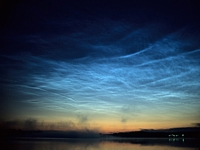
This phenomenon is characterized by appearing about 1 hour after sunset. They are silver-blue clouds with a noticeable spike or grid shape, which form at about 80 km altitude, where temperatures are below -100 ºC. The explanation for the formation of this strange type of "clouds that glow" in the dark is that the low amounts of water vapor at that altitude condense into meteoric dust. They are usually seen at high latitudes (between 45º and 60º) and the significant increase in their sightings is possibly due to the associated influence of environmental pollution.
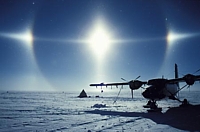
It is a phenomenon of reflection and refraction of sunlight, which occurs when it is low in the sky and there are high cirrus clouds. When light is refracted in hexagonal ice crystals, two bright spots or glows are formed on both sides of the Sun, at about 22º (this is due to the angle of refraction of the light rays); refraction is divided into the colors of the rainbow, which is why it is sometimes possible to see them in the bright spots, just as it should be noted that the parhelion only constitutes the brightest points of a halo that surrounds the Sun, but which rarely achieves look complete. Halos are formed under the same meteorological principle as parhelions.
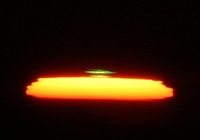
It is a very curious phenomenon and quite difficult to observe, since certain atmospheric conditions are required. It occurs when the Sun rises or sets on a flat surface without obstacles, such as the sea, which must also be free of fog; at this moment, and because the last rays of the Sun are being refracted by the lower Earth's atmosphere from our position, producing the effect that its last rays are yellow and greenish in tone. The green ray is then seen for a few seconds, just before the Sun is about to rise or set, and therefore becomes an interesting target to try to photograph.
It is a very curious phenomenon and quite difficult to observe, since certain atmospheric conditions are required. It occurs when the Sun rises or sets on a flat surface without obstacles, such as the sea, which must also be free of fog; at this moment, and because the last rays of the Sun are being refracted by the lower Earth's atmosphere from our position, producing the effect that its last rays are yellow and greenish in tone. The green ray is then seen for a few seconds, just before the Sun is about to rise or set, and therefore becomes an interesting target to try to photograph.
Astronomical and/or spatial phenomena (natural or artificial)
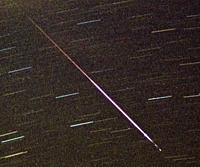
Meteors are dust particles in space (as small as a grain of sand or rice), which when crossing Earth's orbit, are intercepted and impact our atmosphere, burning completely as they pass through it. This process takes only a few seconds, but is usually bright enough to produce a flash visible from Earth. This makes for nice views of meteors streaking across the night sky, sometimes with long trails. On a typical clear night, around 5 meteors can be seen per hour. These dust particles mostly come from the remains of comets, which when passing near the Sun release a large amount of material in the form of meteoroids (dust particles). Meteors are often mistakenly called shooting stars, and a subclassification of them is meteor showers.
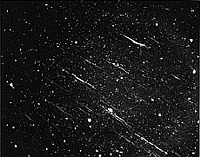
It is a phenomenon in which, during certain days of the year, the number of meteors visible in one night increases considerably. They occur because the Earth in its orbit passes through an area with abundant dust particles, which have been scattered in the form of a trail by some comet; while our planet passes through this area, it is possible to see between 20, 50, even more than 100 meteors per hour (in meteor storms even thousands can be seen per hour). The meteors seem to "come" from a particular region of the sky (the area where the particles are scattered); this region is called radiant, and to help orientate their location, showers are named according to the constellation in which the radiant is located (e.g. if it is in the constellation of Leo it is the Leonid shower; in the constellation of Perseus, the Perseids, etc.). The activity of a shower is "calibrated" by a standard measurement, called Zenital Hourly Rate (THZ) (number of meteors visible by an observer, in 1 hour, with ideal conditions and the radiant at the zenith).
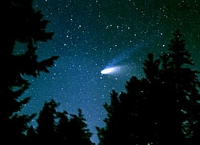
They are widely known celestial bodies, due to their particular configuration: a bright body provided with a "line" either "hair", which can be as long as 1 AU (distance from the Earth to the Sun). Comets are of great importance because they are composed of a wide range of rocky and organic material: some are essential for the appearance of life. These elements are arranged as an icy "crust" on their surface, which does not have a visible tail until it gets close enough to the Sun; at that time, radiation and solar wind cause the comet to release many tons of material in the form of dust and gas, forming the "tail"; this always points away from the Sun, because the tail is simply the material ejected or "pushed" by the solar wind. Comets usually have very long and elliptical orbits, making them return and become visible again every few years.
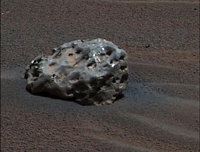
They are small objects that, unlike a meteor, do not completely disintegrate when they pass through the Earth's atmosphere, so they reach the surface forming a crater. They are less than 50 m in size, although it can be said that "large" meteorites are much rarer than small ones (only a few centimetres); meteorites are much less frequent than meteors, due to the action of the atmosphere which destroys most meteoroid particles in a few seconds. This category also includes fireballs, described as "fireballs".fireballs» with a large trail, which are visible for several seconds or minutes, and are usually accompanied by a loud bang/explosion, which destroys part of the meteor, while some fragments reach the surface and become meteorites, although without leaving a crater mark.
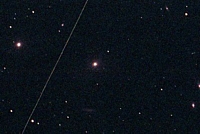
An artificial satellite, in the case of our planet, is any object placed in orbit around the Earth by human beings. This category includes satellites themselves (communications, military, scientific, climate, etc.), as well as other objects, such as International Space Station, the space shuttle or the Hubble space telescope. On a dark, clear night, an artificial satellite can be seen with the naked eye as a faint point that moves faster than the apparent movement of the stars; in fact, an artificial satellite can cover the entire celestial vault in ~5 minutes, and they are easily distinguishable compared to the stars. Objects like the Space Station or the space shuttle are much easier to observe, as long as they pass through the coordinates where you are.

Iridium is a type of communications satellite (66 in total) from the Motorola company put into orbit to provide mobile satellite communications; The main purpose of these satellites went bankrupt and they currently have military applications, but here they have a separate mention because, due to the configuration of their antennas, the Iridium satellites reflect the light of the Sun in a very powerful way, producing flashes that can reach Earth. between magnitude -4 to -7, which is highly bright (the magnitude of the planet Venus is -4). These brief but strong flashes are called Iridium flares. In addition to being curious to observe them (for which you can find out if any will transit our area), these satellites are frequently confused with UFOs.


